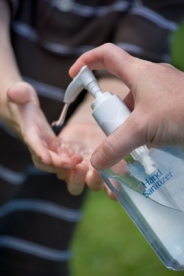Antibacterial Soap
and Other Germ-Fighting Products
Not Effective and Certainly Not Safe
Most people have been led to believe that antibacterial soap and other germ-fighting products will keep them safe from germs and illness.

So much so that many have these kinds of products in their homes. Products like antibacterial liquid hand soap, hand sanitizers, antibacterial household cleaners and other consumer goods that promise to keep their homes "germ-free."
But generally even those that are the most fanatical about using these products still end up getting sick anyway. How can that be?
To put it simply, it's because these products do not do what they claim.
There is absolutely no evidence that antibacterial soap kill germs better than regular soap. The answer always comes back the same – no matter how many studies are done.
But we as consumers are probably used to buying products that don’t do what they say they will. So we’re out a little bit of money. Is it really a big deal? Yes, it actually is.
Triclosan, the key antibacterial ingredient found in these products, is a hazard to our health, animals, and the environment. It's a lose-lose-lose for everyone and everything involved.
Even the American Medical Association (AMA) is uneasy about antibacterial products, saying "it may be prudent to avoid the use of antimicrobial agents in consumer products" (Tan 2002).
So what's so bad about triclosan? Here are some key points:
Use of these products is encouraging bacterial resistance. When you wash your hands with antibacterial soap, it goes into the public water supply and becomes quite dilute. These kinds of conditions encourage harmful bacteria to develop immunity.
Triclosan is just plain toxic to people. This chemical bioaccumulates, meaning it gets trapped in our fatty tissues. Many scientific studies have connected triclosan to cancer, hormone disturbances, birth defects, and liver toxicity. It also creates small amounts of chloroform gas when combined with chlorine in public tap water.
Triclosan is also toxic to wildlife and our environment. It pollutes many bodies of water because of waste water runoff. Animals, like us, are affected even at low levels of exposure and suffer the same effects that we do. Extreme hormonal changes have been most notable.
This pesticide is even commonly being found in the blood and fat of dolphins and other marine mammals. It is that persistent and pervasive.
But avoiding triclosan products can be quite difficult. Since 1995 (when it was introduced) its use has spread rapidly. It's now ubiquitous in most hand soaps, dish soaps, laundry detergents, body washes, shampoos, toothpastes, and LOTS of household cleaning products.
You would think that you'd be able to just look at the ingredient label and see triclosan listed. But that's not the case. Why? It's mostly because of the FDA's inability to do its job in requiring manufactures to provide truthful ingredient labels.
But there are ways we can significantly diminish our exposure to this toxic chemical.
First, look for all of those products that say the following: kills bacteria, fights germs, odor-fighting, keeps food fresher longer, or protects against mold and mildew. Those are all tell-tale signs that triclosan is in the product.
Second, make an effort to find all natural personal products and household cleansers. They can be hard to find, but there are safe products out there that that do a good job at keeping ourselves and our homes clean and fresh.
And don't be afraid of germs. Coming into contact with them on a routine basis helps boost immune system health.
Health and Wellness Home - Organic Body Care - Antibacterial Soaps